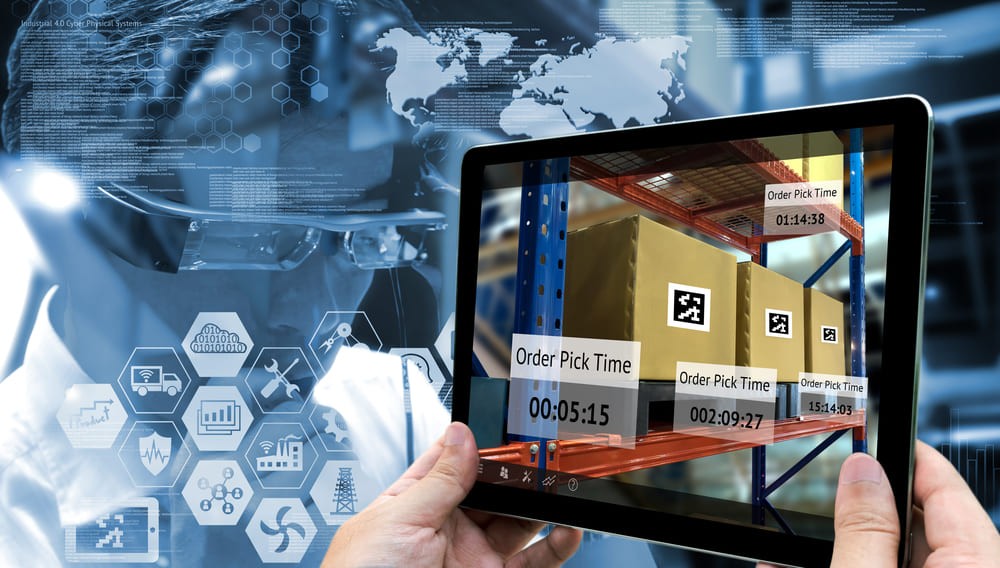Industry 4.0 and the advent of many groundbreaking technologies is already transforming traditional production operations. On top of that, there are global trends and customer demands, which businesses simply cannot ignore. The demand for advanced tech solutions calls for the evolution of supply chains to entirely new levels: the transformation of the company in itself into a digital supply chain.
Needless to say, companies need advanced warehousing, logistics and transportation solutions, while ensuring seamless process management across all links of extended supply chains. Any disruption or failure to ensure smooth coordination between supply chain participants has a negative impact on company operations, sales and stakeholder relationships. In the long run, it negatively influences the economy in general.
That’s why it is imperative that manufacturers harness the power of IoT, analytics and automation to enhance their supply chain performance.
In this article we will focus on embracing digital transformation in supply chain management. But first, we will start with the realistic estimation of major supply chain challenges. Read on to learn more.
Top supply chain challenges
The challenges, both internal and external, are numerous and their number is currently increasing due to growing supply chain complexities. The demand to ensure a faster time-to-market calls for increased accuracy, transparency and coordination across all the supply chain facets, as well as leveraging predictive analytics to prepare for external challenges.
1. Excellent customer service
Successful order fulfillment and customer satisfaction is the ultimate goal of all company operations. Customers want their purchased goods delivered in excellent condition, in the right quantities, to the right location and on time. In today’s competitive business environment attention is increasingly paid to the quality of customer experience.
As simple as it may seem, catering to these basic demands requires seamless operations of all interrelated processes across a supply chain. A while ago, customer order tracking was not even an option. Today, a client’s inability to track an order’s delivery until it reaches its final destination could lead to a major breach of trust between a company and a client.

Gaining a competitive edge requires the introduction of delivery tracking, a more personalized approach and instant notifications on any changing conditions, and calls for complete transparency and visibility of the supply chain processes.
To understand how IoT improves supply chain visibility, think data: capturing, processing, and deriving insights from it, as well as communicating to end customers and intermediary supply chain participants.
As of today, warehouse workers are often unaware of their current product condition and find it challenging to ensure an optimal storage environment once it reaches the warehouse. With IoT sensors on company vehicles, a warehouse can be notified on the condition of a product prior to its delivery (as well as on the exact delivery time, for that matter), and prepare accordingly.
As we finish the overview of some of the challenges, we would like to give you some more examples of how big data can positively transform the supply chain.
2. Effective cost control
Successful supply chain management is a constant balancing act between ensuring its non-disruptive workflow and keeping operational expenses within budget.
Global price fluctuations, regulatory restrictions, investments into equipment and new technologies, energy and fuel costs, increasing monthly salaries and hourly rates: admittedly, predicting and managing expenses is a major supply chain challenge, which manufactures can meet by embracing the supply chain transformation initiatives.
3. Risk management and planning
As mentioned above, no business exists as a separate entity: there are lots of external forces which may potentially disrupt a supply chain.
Natural disasters, political unrests, labor strikes, credit crisis and currency fluctuations fall under the category of unforeseen obstacles and call for careful planning, and developing advanced risk management scenarios. Once a disaster occurs, there’s no time for planning and risk assessment, so organizations simply can’t afford to neglect the benefits of predictive analytics in the supply chain.

4. Strong supplier/partner relationships
High business standards dictate the need for transparency and visibility across all supply chain facets. It goes without saying that maintaining strong supplier and partner relationships with all supply chain participants is imperative. A strong relationship ultimately means the parties are on the same page when it comes to performance assessment and quality standards, and are capable of effectively synchronizing their efforts to reach common goals.
The failure to reach a consensus on unified standards, the inability to work as a team and coordinate efforts, delays, miscommunications and corporate red tape are some of the major pitfalls along the way to successful partner relations.
As of today, supply chain automation solutions can also streamline communication between suppliers/partners, and build mutual trust by ensuring supply chain transparency.
5. Bridging the talent gap
At the end of the day, it all boils down to a lack of qualified talent. As supply chain management becomes increasingly more complex, and organizations start to realize its value, the demand for knowledgeable experts will grow simultaneously.
Unfortunately, as of today, it exceeds the supply. The skill sets required nowadays for successful supply chain management include not only the understanding of the main management roles, but also a profound understanding of technological solutions leading to enhanced supply chain opportunities.
Failing to meet these challenges comes at a high price:
- disrupted workflow and operational downtime
- non-satisfactory customer experience
- overstocking
- underproduction
- waste
- lack of end-to-end supply chain visibility
- financial and reputational losses
To mitigate these risks, companies should identify their current bottlenecks and work on eliminating them through the use of emerging technologies. Fortunately, though, supply chain transformation initiatives can help harness IoT, data analytics and robotic process automation to enhance operational efficiency.

Digital transformation for supply chain and its benefits
Enterprise digital transformation is a hot topic these days. It’s amazing though, how few C-level executives recognize the value of digital transformation in a supply chain. A recently-published McKinsey review found that only 2% of the executives that took part in the survey had some kind of a supply chain digital transformation strategy.
On average, a typical enterprise supply chain is only 43% digitized. The good news is organizations that do embrace the supply chain digital transformation may expect a 2.3% annual revenue growth and stay ahead of their competitors.
IoT, big data analytics and automation open a great number of opportunities to optimize supply chain processes through digitization:
- optimal supplier selection through leveraging advanced analytics
- state-of-the- art inventory management: automated stock counts, predictive procurement, etc.
- tracking the movement of goods through GPS on company trucks and vehicles
- monitoring the product’s condition through IoT sensors and beacons (for example, high temperature levels could indicate potential risks)
- predictive analytics taking into account both internal factors as well as current micro and macroeconomic indicators
- risk mitigation, etc.
In a nutshell, the supply chain of the future should have all it takes to be faster, and more flexible than it is now. Reducing delivery time, and ensuring timely deliveries by monitoring external factors, staying flexible due to reduced planning cycles, fostering a personalized approach to each customer, and providing end-to-end visibility through every facet of the supply chain, will ultimately translate into maximum performance efficiency.

Some of the below supply chain transformation examples are quite spectacular:
Supply chain analytics
A supplier’s trustworthiness and reliability is one of the key factors impacting successful supply chain management. In a business dependent on the quality of supplied parts and raw materials, a supplier analysis can not only ensure a high quality of end products, but also help organizations achieve a substantial reduction of annual spendings.
Boeing Commercial Airplanes Group (BCAG) is successfully applying supply chain analytics to manage its impressive supply chain of more than 3000 companies. To evaluate this number of suppliers by a range of specific criteria, the BCAG has to leverage sophisticated data analytics.
The company then uses insights derived from this data to assign a golden, silver or bronze status to its suppliers and thus manage supplier relations. The supplier evaluation program also has a financial goal: the company aims to achieve a 3-5% reduction of annual spendings by making optimal use of supply chain data analytics.
IoT use cases in supply chains
As of today, 30% of food products worldwide get wasted in supply chains. This waste could be avoided if food manufacturers knew how IoT helps supply chain management track and control storage and transportation conditions. IoT sensors deliver terabytes of data helping track shipments, control warehouse inventory or the quality of raw materials. When applied in supply chains, IoT helps predict disruptions and avoid losses.
IoT in supply chain management also assists in aligning sales and operations planning with varying conditions and challenges within a supply chain.
For example, the renowned tire manufacturer Michelin Group has set up а daughter company, Michelin Solutions offering IoT based tools for tracking tire replacements and oil changes of particular vehicles. Based on this data, businesses can achieve more accuracy in sales and operations planning as well as in predicting expenses.

Robotic process automation in supply chain management
As we talk about opportunities in supply chain management, we certainly, cannot overlook supply chain automation solutions. As complicated as AI may appear to be, it starts with streamlining and automating routine rule-based processes. There are lots of monotonous, repetitive tasks RPA algorithms can handle better than humans.
Applied in supply chain management, robotic process automation removes the human factor which often leads to mistakes and inaccuracies as well as helps deliver a better time-to-market.
Robotic process automation in supply chain streamlines the lengthy process of answering common queries by merging RPA with NLP. Coupled with predictive analytics, RPA helps identify bottlenecks along a supply chain and build better processes by eliminating them.
Other vivid examples of supply chain automation involve blockchain technology. IBM and Maersk are currently using blockchain to optimize document flow between the two organizations, reduce errors and increase productivity. With business critical documentation stored in a blockchain, there’s no longer any need for sending documents back and forth until they get signed and approved by both parties.
The Bottom line
Surely, not only giants like Boeing, IBM and Michelin can enjoy the supply chain digital transformation benefits. In a challenging business environment, state-of-the-art optimization of all the supply chain processes is vitally important for SME companies that want to stay afloat.
Optimizing the supply chain through IoT, Analytics and Automation can be a challenge in itself, though. With obstacles like legacy systems, a lack of integration with other organizational processes and personnel resisting changes, the risks of incorrectly implementing emerging technological solutions may even be higher than not implementing them at all.
At Eastern Peak we focus on developing tailored solutions aimed at meeting your specific business needs. To get a better picture of how your organization can benefit from digital transformation in the supply chain and avoid risks, contact our expert team now and get a free consultation.
Read also:



